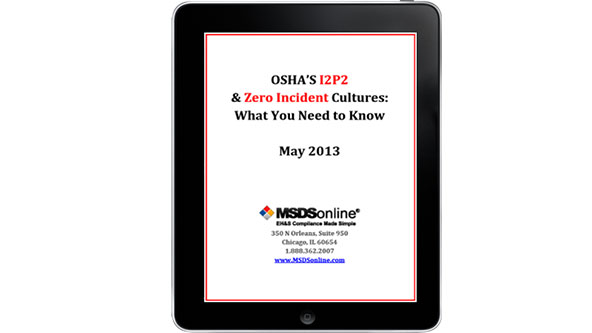New I2P2 Fact Sheet from OSHA and White Paper from MSDSonline
06/11/2013

OSHA recently published a new fact sheet on Injury and Illness Prevention Programs (I2P2) that briefly covers the six major elements of what it says constitutes an effective I2P2 implementation. It is one more step forward for the agency in what has been a slow march toward introducing an I2P2 Standard, and comes a year and a half after OSHA published its first white paper on I2P2. That white paper focused primarily on building the political, financial and social arguments in favor of a new standard.
Dr. David Michaels, director of OSHA, has set his sights on having a proposed rule on I2P2 published by the end of the year. While that time-frame seems aggressive in the current regulatory landscape, there is no denying that OSHA continues to keep the standard front and center in its messaging.
Click Here to Download Free I2P2 White Paper
To help companies get a better handle on I2P2 and the six major elements OSHA has touched on in the new fact sheet, MSDSonline recently published its own I2P2 White Paper that takes readers through a practical and in-depth look at how employers can implement I2P2 based strategies in the workplace.
The six major elements of an effective injury and illness prevention program as identified by OSHA are as follows:
- Management Leadership
- Worker Participation
- Hazard Identification and Assessment
- Hazard Prevention and Control
- Education and Training
- Program Evaluation and Improvement
In OSHA's recently published 2014 Congressional Budget Justification the agency says, "its current highest rulemaking priority is the Injury and Illness Prevention Program (I2P2) rule. I2P2 will produce a significant change in how workplace safety is approached in this country and will substantially reduce the number and severity of workplace injuries and alleviate the associated financial burdens on U.S. workplaces and the U.S. economy, thereby contributing to American economic competitiveness."
Those financial burdens can be quite significant according to a recent e-blast from the National Safety Council, which says work injuries cost employers $188.9 billion in 2011, with a cost per worker of $1,340, a cost per death of $1,390,000 and a cost per medically consulted injury of $37,000.
To learn more about the ways electronic injury and illness recordkeeping and near miss tracking can mitigate workplace risks and help with I2P2 integration, visit the VelocityEHS Incident Management page.






